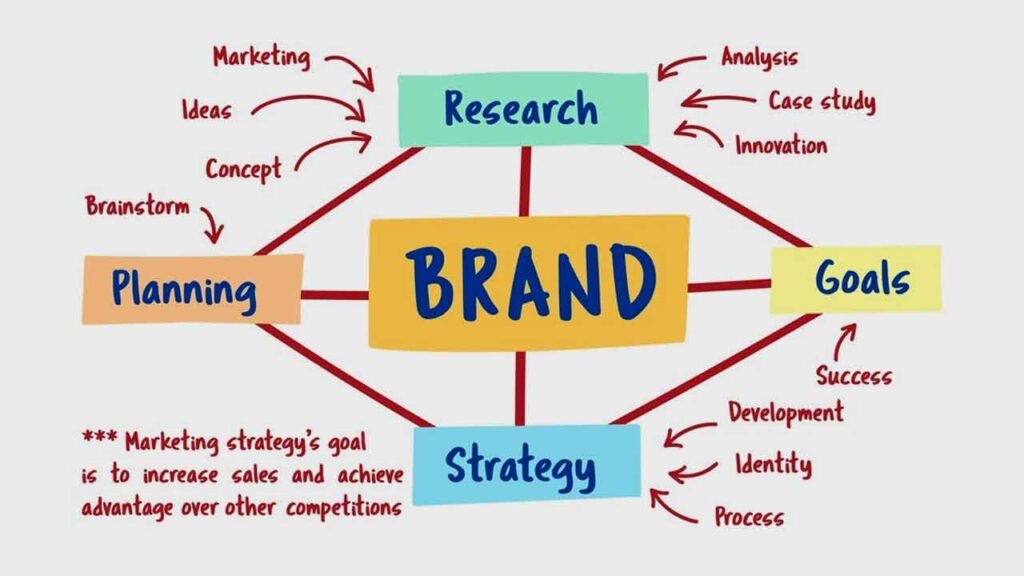Brand innovation involves identifying new opportunities, such as exploring tech startup ideas, to evolve and expand your brand. It entails creating an immersive experience that fosters recognition, trust, and loyalty among consumers. Iconic corporations such as Coca-Cola, Starbucks, and Apple have masterfully harnessed the art of branding to create not just products but rather holistic experiences. Brand management necessitates a comprehensive understanding of your brand’s identity and ensuring that every element of your company, ranging from visuals to language to customer interactions, aligns with those core values.
Today, I will furnish you with a beginner’s guide to brand management that encompasses a diverse array of topics, including how to devise a potent brand strategy, execute design standards with precision, and maintain consistency of brand values across all areas of your business. The result will be a comprehensive toolkit to assist you in constructing or refining an effective brand management strategy that will take your business to the next level.
Brand Management Definition
Brand management is a multifaceted process that entails developing and implementing intricate strategies geared toward shaping the assessment of a product/service in the minds of consumers. The core objective is to ensure that the brand is uniformly represented across all touchpoints, instilling a sense of familiarity and trust in the target audience. A vital aspect is creating a coherent messaging framework that conveys the brand’s distinctive qualities in a manner that resonates with the intended audience.
The ultimate aim is to establish a robust brand identity that is synonymous with quality and reliability, thereby generating brand equity and nurturing customer loyalty, which in turn can lead to heightened revenue and market share. Achieving this requires a keen understanding of customer preferences and needs, which you can glean through market research and customer feedback. Additionally, careful planning and precise execution of marketing, design, and customer engagement initiatives are pivotal in ensuring that your brand management strategy is successful.

10 Key Elements of Brand Management
Brand Identity:

First up is brand identity – the visual elements that make up your brand, like your logo, colors, typography, tagline, and brand voice. Yeah, that’s right, your brand voice – it’s the tone and style you use when communicating with your audience. A good brand identity helps customers recognize and remember your brand and sets you apart from the competition. But that’s just the tip of the iceberg!
Brand Positioning:

It is where the real meat and potatoes are. It’s all about how your brand is perceived in the market. Are you aware of your target audience? What do they care about? How can you differentiate your brand from competitors? Brand positioning is about finding your unique place in the market and making sure your customers know why you’re the best choice for them. It’s a game of strategy that you need to play if you want to succeed.
Brand Promise:

What does your brand stand for? What does it offer to consumers? Your brand promise is the pledge you make to your customers, the assurance that they’ll receive a specific benefit or experience from doing business with you. Your brand promise sets expectations for customers and helps build their trust and loyalty. And let me tell you, trust and loyalty are no easy feats to achieve in this dog-eat-dog world.
Brand Personality:

It’s the human characteristics associated with your brand. Think of it as the personality traits that your brand would have if it were a person. Are you serious and professional or fun and playful? Whatever your brand personality is, it should be consistent across all your marketing and communication efforts to build a solid and memorable brand. It’s about creating a connection with your customers, so they keep returning for more.
Brand Equity:

This almighty power can elevate a mere product or service to a stratospheric level. It’s total of people’s emotions, perceptions, and attitudes about your brand. A brand with high equity can lead to higher sales, fierce customer loyalty, and top-of-mind awareness. By embracing brand management, businesses can build and nurture brand equity to create long-lasting value and an insurmountable competitive advantage.
Brand Assets:

Your brand assets are visible and invisible aspects of your product, such as patents, trademarks, copyrights, and customer data. You can leverage these assets to amplify brand equity and generate new revenue streams. By knowing and protecting your brand assets, you ensure your brand remains vigorous and adaptable in the face of competition and changing market trends.
Brand Innovation:

To stay ahead of the pack, it’s necessary to continuously improve your brand by creating new products, services, and marketing strategies. By embracing brand innovation, you can keep your brand contemporary, relevant, and stimulating for your customers and gain a competitive advantage over slower, less adaptive rivals. Investing in brand innovation makes sure your brand maintains its industry-leading status and can build brand equity over the long haul.
Brand Story:

Last but certainly not least, we have brand story. Your brand story is the history and values behind your brand. The narrative that you use to connect with customers and build an emotional connection with them. It’s about sharing your company’s journey, the values you hold dear, and the impact you want to have on the world. A compelling brand story helps you build trust and loyalty with your customers, as they see that you’re not just another faceless corporation but a group of people with a mission and a purpose.
Concisely, the crucial elements of brand management involve optimizing brand identity, positioning, promise, personality, and story. It also means safeguarding and exploiting your brand assets, investing in brand innovation, and building brand equity. By creating a strong and prosperous brand, you can establish yourself as a market leader and guarantee long-term success.
Brand ambassadors:

Brand advocates are individuals external to the organization who opt to endorse your brand. Historically, numerous major companies compensated famous figures to endorse their products. However, for smaller enterprises, leveraging genuine customers and social media influencers proves to be a more impactful advocacy approach.
In today’s market, consumers value authenticity and are more receptive to recommendations from ordinary people. These real customers share the same interests and concerns as your target audience, making their support for your products relevant and trustworthy.
When developing your brand, consider how each aspect complements the others. Every communication or action aimed at promoting your business conveys a message to your customers.
Similar to a person, a brand possesses multiple layers that evolve over time. However, maintaining consistency between your brand image, the narratives you share, and the commitments you make to customers is crucial.
Brand perception:

The way your brand is perceived reflects how customers truly see your business. Despite claims of being the top home painter, dissatisfaction arises if the paint begins peeling shortly after.
Client expectations and viewpoints evolve from your business portrayal, constituting what is termed perception, either favorable or unfavorable. Each interaction with your business either reinforces or weakens these perceptions.
To foster business growth, ensure that customer perceptions are in harmony with your brand image.
Brand Management Plan – 5 Crucial Steps To Follow

1. Define Your Brand
To effectively manage your brand, you must take several complex and interrelated steps. First, you must embark on a perilous journey to define your brand, its identity, positioning, promise, personality, and story. Only then can you build a stable foundation for your marketing and communication efforts and forge a strong and lasting bond with your customers.
2. Develop a Consistent Brand Voice
Don’t stop there, though! You must also develop a consistent brand voice that can speak for your brand in all touchpoints. You must ensure your brand’s tone, style, and messaging are coherent across all channels, including your website, social media, and other communication channels. Consistency is the key to building trust and recognition with your customers and making your brand memorable.
3. Establish Brand Guidelines
But how can you ensure that your visuals are as consistent as your messaging? Establish brand guidelines, my friend. You should cover everything from your brand’s logo and color palette to typography and design elements. Having clear guidelines will help you maintain brand consistency and coherence.
4. Monitor and Manage Your Brand Reputation
Managing your brand’s reputation is another critical aspect of brand management. Monitor and manage your brand reputation in real time by staying on top of social media, online reviews, and other channels to address any negative feedback or issues as soon as they arise. You can build a positive brand reputation and maintain customer trust by handling problems promptly and proficiently.
5. Continuously Evaluate and Adjust Your Brand Strategy
If all that wasn’t enough, you must constantly evaluate and adjust your brand strategy to keep up with the ever-shifting market landscape. Staying on top of industry trends, customer needs, and changing market conditions is vital to maintaining your brand’s relevance and competitiveness over the long term.
By undertaking these daunting steps and persevering through the perilous journey of brand management, you can create a brand that towers above the competition, fosters deep customer loyalty, and drives long-term success.
Top 3 Brand Management Challenges You Should Not Take Too Lightly
Now that you know the steps to build a strong brand, you must also understand the management challenges. Brand administration is a continuous uphill battle that can be riddled with challenges. Let’s take a keener look at some of the critical challenges of brand management:
1. Striking a Balance Between Brand Consistency and Innovation
One of the most formidable challenges of brand management is striking the right balance between brand consistency and innovation. On the one hand, maintaining a consistent brand identity is essential to building a strong and recognizable brand that customers can trust. On the other hand, your brand needs to evolve and adapt to meet your customer’s ever-changing requirements and preferences to remain competitive in a constantly changing market. Achieving the perfect balance between consistency and innovation requires skillful planning, careful execution, and a willingness to take risks.
2. Tackling the Complexities of Reputation Management in the Digital Age
The digital age has brought about new and complex challenges to managing a brand’s reputation. With social media and review platforms, it’s easier than ever for customers to voice their opinions and share feedback. However, negative comments or feedback can quickly spread and potentially cause irreversible damage to your brand’s reputation. You must have a proactive approach to monitoring and respond to feedback. Do it while maintaining authenticity and transparency in your communications to maintain your reputation.
3. Standing Out in an Overcrowded Market
In a market that’s oversaturated with brands, it’s not enough to have a good product or service. Your brand must stand out and differentiate itself from its competitors to achieve success. It requires a profound identification of customer demands and likings, creating a unique and memorable brand identity, and developing a brand experience that caters to those needs.
Summary
At its core, brand management involves developing a unique and memorable brand identity, establishing a consistent voice and message, and actively managing your reputation. However, creating a successful brand isn’t easy. It requires balancing consistency with innovation and navigating the complexities of social media and online review platforms.
The key to success is prioritizing ongoing attention and adaptation, which means maintaining a clear brand identity, delivering a consistent brand experience, and proactively managing your reputation. With effective brand management, companies can build strong brands that drive customer loyalty and create long-term value.
In short, brand management is essential for your success in a crowded market, and it requires ongoing effort and attention to build and maintain a strong brand.
Brand Management FAQs
- Do you know brand architecture, and how does it relate to brand management?
Brand architecture is the way a company organizes its brands and sub-brands. It entails how you name and brand your products and services and how they relate to the overarching corporate brand. Effective brand architecture is essential to brand management, as it helps ensure consistency and clarity in the company’s brand identity and messaging.
- How can I conduct a brand audit for my company?
A brand audit evaluates your company’s brand assets and how customers and stakeholders perceive them. To conduct a brand audit, you may want to review your company’s visual identity, messaging, customer feedback and reviews, and competitive landscape. It can help identify areas where your brand is strong, as well as spaces where it may need improvement.
- What are some best practices for brand voice and messaging?
To ensure consistency and clarity in your brand voice and message, you should define your brand’s tone, style, and key messaging points. You may also want to create brand guidelines that provide specific guidance on using language and tone in different types of communications, such as social media, email, or print materials.
- How can I use social media to build my brand?
Social media is an influential platform for fabricating your brand, as it allows you to connect with customers and share your brand message more informally and engagingly. To use social media effectively for brand management, employ a clear strategy that aligns with your overall brand identity and messaging. Write content that echoes with your focus viewers, engage with followers and customers, and monitor and respond to customer feedback.
- How can I ensure brand consistency across different channels and touchpoints?
To ensure brand consistency, you should develop a brand style guide that outlines your brand’s visual and verbal identity, use consistent messaging across different channels, train your team, monitor your channels, test and adapt your messaging, and engage with your audience.
- What is the role of brand innovation in brand management?
Brand innovation involves identifying and pursuing new opportunities to evolve and expand your brand. It comprises launching new products or services, entering new markets, or repositioning your brand to appeal to a different audience. It also helps ensure your brand remains relevant and competitive in a rapidly changing market.
- How can I gauge the success of my brand management efforts?
For this purpose, you may want to track metrics such as customer engagement, brand awareness, and customer loyalty. You can also conduct customer surveys or focus groups to gather feedback on how customers perceive your brand and how you can improve. By regularly evaluating and adjusting your brand management strategy, you ensure your brand continues to resonate with your target audience and drives long-term value for your company.
